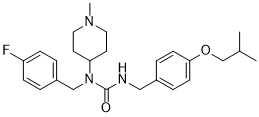This product is for research use only, not for human use. We do not sell to patients.

| Size | Price | Stock |
|---|---|---|
| 1g | $550 | Check With Us |
| 2g | $900 | Check With Us |
| 5g | $1400 | Check With Us |
Cat #: V3349 CAS #: 706779-91-1 Purity ≥ 98%
Description: Pimavanserin (formerly ACP-103; BVF-036; trade name Nuplazid) is an orally bioactive and selective inverse agonist of the 5-HT2A (serotonin receptor subtype 2A, pIC50 and pKd of 8.73 and 9.3, respectively) receptor approved as an atypical antipsychotic for the treatment of Parkinson's disease psychosis.
Publications Citing InvivoChem Products
Product Promise

- Physicochemical and Storage Information
- Protocol
- Related Biological Data
- Stock Solution Preparation
- Quality Control Documentation
| Molecular Weight (MW) | 427.56 |
|---|---|
| Molecular Formula | C25H34FN3O2 |
| CAS No. | 706779-91-1 |
| Storage | -20℃ for 3 years in powder formr |
| -80℃ for 2 years in solvent | |
| Solubility In Vitro | DMSO: ≥ 50mg/mLr |
| Water: N/Ar | |
| Ethanol: N/A | |
| SMILES Code | O=C(NCC1=CC=C(OCC(C)C)C=C1)N(CC2=CC=C(F)C=C2)C3CCN(C)CC3 |
| Synonyms | ACP-103; BVF-036; ACP 103; BVF036; ACP103; Trade name: Nuplazid |
| Protocol | In Vitro | Pimavanserin (ACP-103) competitively antagonizes the binding of [3H]ketanserin to heterologously expressed human 5-HT2A receptors with a mean pKi of 9.3 in membranes and 9.70 in whole cells. Pimavanserin demonstrates lesser affinity (mean pKi of 8.80 in membranes and 8.00 in whole cells, as determined by radioligand binding) and potency as an inverse agonist (mean pIC50 7.1 in R-SAT) at human 5-HT2C receptors, and lacked affinity and functional activity at 5-HT2B receptors, dopamine D2 receptors, and other human monoaminergic receptors |
|---|---|---|
| In Vivo | Pimavanserin (ACP-103) is a potent, efficacious, orally active 5-HT2A receptor inverse agonist with a behavioral pharmacological profile consistent with utility as an antipsychotic agent. Pimavanserin attenuates head-twitch behavior (3 mg/kg p.o.), and prepulse inhibition deficits (1-10 mg/kg s.c.) induced by the 5-HT2A receptor agonist (±)-2,5-dimethoxy-4-iodoamphetamine hydrochloride in rats and reduces the hyperactivity induced in mice by the N-methyl-D-aspartate receptor noncompetitive antagonist 5H-dibenzo[a,d]cyclohepten-5,10-imine (dizocilpine maleate; MK-801) (0.1 and 0.3 mg/kg s.c.; 3 mg/kg p.o.), consistent with a 5-HT2A receptor mechanism of action in vivo and antipsychotic-like efficacy. Pimavanserin demonstrates >42.6% oral bioavailability in rats |
| Solvent volume to be added | Mass (the weight of a compound) | |||
|---|---|---|---|---|
| Mother liquor concentration | 1mg | 5mg | 10mg | 20mg |
| 1mM | 2.3389 mL | 11.6943 mL | 23.3885 mL | 46.7771 mL |
| 5mM | 0.4678 mL | 2.3389 mL | 4.6777 mL | 9.3554 mL |
| 10mM | 0.2339 mL | 1.1694 mL | 2.3389 mL | 4.6777 mL |
| 20mM | 0.1169 mL | 0.5847 mL | 1.1694 mL | 2.3389 mL |
This equation is commonly abbreviated as: C1 V1 = C2 V2
- (1) Please be sure that the solution is clear before the addition of next solvent. Dissolution methods like vortex, ultrasound or warming and heat may be used to aid dissolving.
- (2) Be sure to add the solvent(s) in order.




































